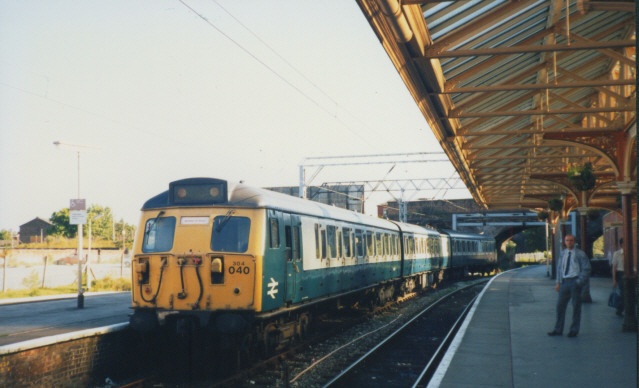- British Rail Class 304
Infobox EMU
name = British Rail Class 304
imagesize = 300px
caption = A Class 304 EMU seen atAltrincham railway station
background = #012545
Manufacturer = BR Wolverton
Formation = 4 cars per trainset
Built =
InService = 1959 - 1996
Refurbishment=1980
Weight = Total - 151tons 17cwt
Capacity =
MaxSpeed = 75mph 121km/k
Gauge =
Brakes = Air (EP/Auto)
Engine =
Operator =British Rail The British Rail Class 304
electric multiple unit s were built for suburban use on the first phases of theWest Coast Main Line electrification betweenCrewe andManchester /Liverpool /Rugby. Originally classed as AM4 units, they later became Class 304 under theTOPS numbering system, and could be found in operation over most of the southern West Coast Main Line. The units conformed to the 1959-design foralternating current (AC) electrical multiple units, and were externally very similar to the Class 305, Class 308 and the 1,200 Vdirect current (DC) class Class 504 units. No units survived preservation, and all units were eventually scrapped.Description
The first fifteen units were delivered to Longsight Depot, Manchester from April
1960 as four-car sets, and were originally numbered 001-015. Built by British Rail's Wolverton Works, these units were an aesthetic improvement over the AM2 (Class 302) units previously built at York and Doncaster; they featured a new design cab end with a raked back upper area, following a Design Panel recommendation, and emerged in Multiple Unit Green livery, lined out with yellow. The units followed the two-car 1,200V DC Class 504 units off the production line at Wolverton, a class which shared many design features with the first AM4 units. The units were arranged into four-car sets, consisting of: a Driving Trailer Brake Open vehicle with 82 second class seats (saloon) and a Guard's compartment; a Trailer Composite with 19 first class seats (compartment) and 60 second class seats (saloon), and two toilets; a Motor Brake with 96 second class seats (compartment) and a Guard's compartment; a Driving Trailer with 82 second class seats (saloon), two toilets, and battery equipment. One result of the Motor Brake vehicle having a compartment design was that the window layout on all vehicles was designed to suit, having a narrow window either side of each door. The units were tested on the Styal line prior to the start of electric services between Crewe and Manchester.A further twenty units followed in 1961, numbered 016-035 and intended for the Crewe-Liverpool service. These units differed from the first batch by having a slightly different body design, with wide saloon windows replacing the narrow compartment-style windows. The Motor Brake vehicles had a different internal layout, with 72 second class seats in saloon layout. This improved layout was adopted for the final batch of AM4s, as well as later batches of AM5 (Class 305) units and AM8 (Class 308) units. Some of this second batch were loaned temporarily to the Eastern Region for use between Liverpool Street and
Shenfield /Southend-on-Sea during the conversion of this route from 1,500V DC to 6.25kV/25kV AC, while Class 306 and Class 307 units were being rebuilt.The third and final batch of AM4 was another ten units, numbered 036-045, which were almost identical to the second batch and intended for use on the Crewe-Rugby section.
Surprisingly, the AM4s were the only AC units of the 1959 design to wear the lined-out version of Multiple Unit Green livery, with Classes 305 and 308 emerging in comparatively drab plain green. This pleasant appearance was lost, however, when repainted into all-over
Rail Blue . The units spent their whole careers operating between Crewe and Manchester/Liverpool/Birmingham/Rugby/Northampton. Some units were occasionally operated to London Euston orPreston , but only rarely.Refurbishment
In the early 1980s, a refurbishment programme was carried out on the units. This included the removal and scrapping of the Trailer Composite vehicles, reducing the units to three-car formation, and the conversion of the Motor Brake vehicles of the first batch (Class 304/1) to saloon layout, reducing seating capacity to 72. Unlike other EMU refurbishment programmes, the work carried out on Class 304 units did not include the fitting of inter-vehicle gangways, or the complete replacement of internal fittings. This meant that original 1960s seats and trim remained in most vehicles, retaining something of their original character. The units were also repainted into blue and grey livery. The loss of one vehicle meant that the
power-to-weight ratio of the units increased, thereby improving their performance.Decline
In the 1980s the units gradually received the Class '304'
TOPS prefix to their unit numbers, and by 1992 several later series units had even received Regional Railways livery. By this time, however, more recently refurbished Class 305 units had become available, displaced from theLondon, Tilbury and Southend Railway by Class 317s, and with the imminent arrival of brand new Class 323s, the Class 304s began to be withdrawn. The end came in March 1996 when 304002 and 304033 ran a series of farewell specials in Birmingham. Known amongst enthusiasts as "Dinosaurs", due to their advancing age, Class 304s followed their namesakes to extinction.Preservation Attempts
304021 was purchased for preservation in 1998 and was stored in sidings in
Stafford . Unfortunately, during this time many windows were smashed, which, as a consequence of the cost of replacing them, led to the abandonment of the project. The long period of storage was due to the difficulty in finding a home on a preserved railway for EMU coaching stock, and so it became the last of its class to be scrapped in November2000 .
Wikimedia Foundation. 2010.
